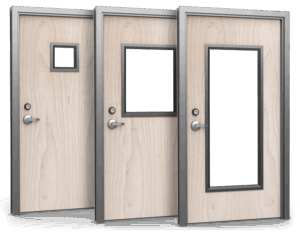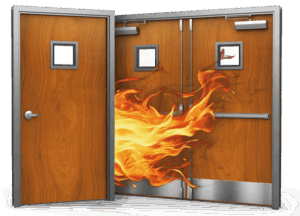Do Commercial Wood Doors Offer Energy Efficiency?
Yes, commercial wood doors can offer good energy efficiency, especially when properly constructed and installed. Solid core wood doors provide natural insulation due to the density of the wood, helping to reduce heat transfer and maintain indoor temperatures. Many commercial wood doors also include energy-efficient features like insulated cores, weather stripping, and tight seals to minimize air leakage. Choosing energy-efficient wood doors can contribute to lower heating and cooling costs and support sustainable building goals.



What features make commercial wood doors more energy efficient?
Commercial wood doors become more energy efficient through several features:
- Insulated Core: One of the most important factors in improving energy efficiency is the type of core material. Wood doors with insulated cores (such as polystyrene, polyurethane, or expanded polystyrene) offer better thermal resistance than standard solid wood doors, helping to reduce heat transfer.
- Weatherstripping: Adding weatherstripping around the edges of the door helps prevent drafts by sealing gaps between the door and the frame, which can significantly reduce energy loss.
- Proper Sealing: In addition to weatherstripping, ensuring the door is properly sealed around all edges prevents air leaks. This includes sealing the top, bottom, and sides of the door to maintain indoor temperature control.
- Energy-Efficient Coatings: Some commercial wood doors come with energy-efficient coatings that help reduce heat transfer and improve thermal performance. These coatings reflect heat in warmer months and retain heat in cooler months, enhancing the door’s overall energy efficiency.
- Heavy Duty Thresholds and Bottom Seals: Installing heavy-duty thresholds and bottom seals can help further reduce air infiltration at the door’s base, which is a common area for energy loss.
- Multi-Point Locking Systems: Multi-point locks can provide a more secure, tighter seal along the door frame, improving the overall energy efficiency by minimizing gaps where air can escape.
These features can help ensure that your commercial wood door performs efficiently, keeping energy costs lower by better maintaining indoor temperatures.
Are commercial wood doors better insulators than commercial metal doors?
Generally, commercial wood doors offer better natural insulation than commercial metal doors because wood is a poor conductor of heat, which helps reduce thermal transfer. However, many metal doors include insulated cores, such as foam or honeycomb cores, that can provide equal or even superior energy efficiency compared to solid wood doors. So, while wood itself insulates well, the overall energy efficiency depends on the door’s construction and insulation materials rather than just the surface material.
Can energy-efficient wood doors help reduce utility costs?
Yes, energy-efficient wood doors can help reduce utility costs by minimizing heat loss in the winter and heat gain in the summer. Their natural insulating properties, combined with features like insulated cores, weather stripping, and tight seals, help maintain a stable indoor temperature. This reduces the workload on heating and cooling systems, leading to lower energy consumption and cost savings over time.
Do energy-efficient wood doors qualify for green building certifications?
Yes, energy-efficient wood doors can contribute to green building certifications such as LEED (Leadership in Energy and Environmental Design). Using doors with high insulation values, sustainably sourced materials, and low-emission finishes can earn points toward certification. These doors help improve a building’s overall energy performance, reduce environmental impact, and support sustainable design goals required by many green building programs.
Is professional installation important for maximizing energy efficiency?
Yes, professional installation is crucial for maximizing the energy efficiency of commercial wood doors. Even the best-designed doors can lose effectiveness if gaps, misalignments, or poor sealing occur during installation. Skilled installers ensure the door fits properly within the frame, apply weather stripping correctly, and seal all edges to prevent air leaks and thermal bridging. Proper installation helps maintain consistent indoor temperatures, reduces drafts, and ensures the door performs as intended for energy savings.
Are there building codes or standards for energy efficiency in commercial doors?
Yes, many building codes and energy standards include requirements for the energy efficiency of commercial doors. For example, the International Energy Conservation Code (IECC) sets performance criteria for doors related to thermal insulation (R-value or U-factor) and air leakage. Additionally, standards from organizations like the American Society of Heating, Refrigerating and Air-Conditioning Engineers (ASHRAE) may apply. Compliance with these codes helps ensure that commercial doors contribute to a building’s overall energy efficiency and meet local regulations.
Are there energy-efficient options for fire-rated commercial wood doors?
Yes, there are energy-efficient options available for fire-rated commercial wood doors. These doors combine fire-resistant materials and construction techniques with insulated cores and tight seals to provide both safety and thermal performance. Manufacturers often use specially engineered cores, such as mineral cores or fire-retardant treated wood composites, paired with weather stripping and precision installation to minimize heat transfer and air leakage. This allows building owners to meet fire safety codes without sacrificing energy efficiency.


How do wood doors compare to other door materials in terms of energy efficiency?
Wood doors naturally offer good insulation because wood is a poor conductor of heat, which helps reduce energy loss. Compared to metal doors, wood generally provides better thermal resistance unless the metal door includes a high-quality insulated core. Fiberglass doors can also be very energy efficient, often combining durable outer layers with insulated cores similar to or better than wood. Ultimately, the energy efficiency of any door depends not just on the material but on the door’s construction, insulation, seals, and installation quality.




